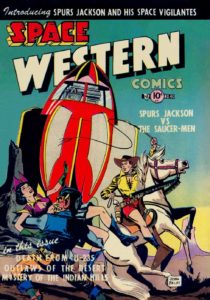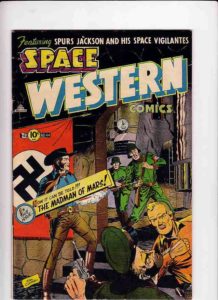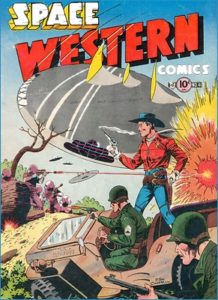After all is said and done, and let’s face it, all has been said and done, you wonder why Charlton did it. They took a cowboy and put him into space. Of course science fiction and westerns can never quite leave each other alone. Star Trek was sold to the network as Wagon Train in space; Firefly not only had a cowboy look, but a Western plot device in the hero who fought for the losing side in a civil war, and Star Wars has the gunslinger figure of Han Solo.
But space westerns have a poor reputation among both those who like westerns and those who like science fiction alike. So the most popular space western (though one not using space travel) is not even recognized as one. In The Wild, Wild West, technology too advanced for the time is central to the series. The technology was ramped up and brought to the fore for the movie version and, let’s face it, that didn’t improve the franchise. Even as late as right now, the space Western continues its half life with DVD sales of Cowboys and Aliens.
But Charlton had neither those successes nor failures to guide it when it started a space Western comic called Space Western Comics. Again, why?
Sure, cowboys were popular in 1950, and science fiction was taking off. Yet if that was the aim, Charlton didn’t stick to it. In “The Outlaws of the Desert,” a truck is about as high as the technology gets. The whole story revolves around bandits who always strike at dawn and no one can figure where they hide (nor do they reschedule deliveries or give at least some of them police protection). It turns out the crooks hide their loot up a hill in a gulch generally thought to be uninhabitable despite the vegetation there: no one thinks to look up.
“Incident at Powder River” tells of two cowboys who come to town. They try to avoid a bank robbery, but when a stray bullet hits one of them, the unwounded one takes care of the bandits. The wounded one is treated and the marshal asks if he knows the men from somewhere. They deny it and leave. When they’ve gone the stage comes in with wanted posters showing the man the marshal spoke to was Jesse James.
There are no stories that are science fiction but not western. So at a guess, Charlton was trying to draw people from Westerns to sf. But what kind of people? By definition, people who want to read about the lead character.
The lead character is Spurs Jackson. Spurs lives in Arizona, in Wyman County (which is in Nebraska), near the town of Aberdeen (which is in South Dakota, unless we’re talking about the one in Ontario). Spurs is a cowboy: he wears six-guns, rides a horse, and wears the hat. He’s also an engineer and has a secret lab, which is mentioned only once, never shown, and more important, never explained. He has invented many items, but it’s not clear what any of these are, though possibly one is a gun that fires miniature atomic bombs.
But for all that, the degree as an engineer, the atomic bomb gun, the things (whatever they are) that he invented, the secret lab; when Spurs Jackson wins, he does it with a six-gun, a whip, a fist, or a conventional (not atomic) bomb. His wins are cowboy wins, not spaceman wins. In “The Madmen of Mars,” Hitler is on Mars and uses atomic bombs to destroy Paris, Moscow, Honolulu, and New York City. In retaliation, Spurs and his friends Hank and Strong Bow go to Mars with six-guns and captured machine guns take down the Nazi gang. Spurs is such a cowboy he doesn’t take machine guns and grenades with him. He doesn’t even take his atomic bomb gun.
And consider the enemies Spurs takes on. Twice he meets Martians who are trying to overthrow their queen, Thula. He faces criminals who steal uranium to build a rocket that will take them to Venus from which they will raid the Earth. He battles Communists who are pretending to be aliens and Hitler on Mars. He faces the Stone Men from the planet Canis, which revolves around the star Sirius (bad puns noted). There are aliens from Venus and aliens who do not come from the sun as they claim, but from a planet around a star twelve lightyears from the sun that went nova (there is no such nova but Tau Ceti is 12 light years away and coincidentally has a possibly habitable planet).
The stories obviously could go in any direction, from bank robbers to Hitler to aliens. Maybe that was part of the appeal. It was hard to get an idea that didn’t fit the backdrop and that’s a boon for an underpaid writer.
And yet you still have to wonder why. There is no gem amidst the junk, here. Why make a comic you don’t care about at any level? The artwork is bad, the coloring is slip-shod, the science is reprehensible. Worse than all of that are the stories, but more on that in a minute.
The artwork is badly done. Little wonder when at the time Charlton paid $13 per page, most comic book publishers paid $20 per page, and EC paid $25. At those prices only somebody like Steve Ditko would do their best work. But that excuse does nothing for the customer and says nothing for the colorist or printer.
The lack of quality in these areas is constant. Faces are crudely drawn, the poses of some figures are unbelievable at best and physically impossible at worst. In “The Saucer Men,” the Martian flying saucers are sometimes pure yellow and other times have green highlights. The coloring of the Martian collars that hold their helmets can be yellow in one panel and green in the next.
Queen Thula has black hair, except in two stories where it suddenly turns blonde. However, when Thula’s hair is blonde, it is exactly the same color and style as two human characters. It seems a colorist just looked quickly at a story and transposed hair colors. Given the bad pay, colorists probably just shovelled the work out fast enough to build a decent income.
The Spurs Jackson tales are bad. There are three main things wrong. The stories depend on coincidences. The dialogue is clichéd and not always appropriate. And above all else, they are just too convenient. Take “The Saucer Men.”
By pure coincidence, Martian flying saucers land near the ranch Spurs Jackson owns. Korok the Martian takes Spurs and his friends Hank and Strong Bow to Mars, where we discover it was all a trick. According to queen Thula, when Korok had conquered the Earth, he would take the throne of Mars.
Why would you make such a law? Why does it apply specifically to Korok? Why are these Earth people’s presence proof? Why does no one think to ask those Earth people if Earth has been conquered? Supposedly random elements all just happen to come together in an unbelievable way in story after story.
And what do they say during this adventure? Things like, “Strong Bow heard scientists tell Spurs Jackson that flying saucers are just an illusion – so Strong Bow prefers horse-shoes.” What? “Well, well, don’t tell me you come from Mars.” “Naturally we are from Mars…” Yeah.
But the worst thing about the story is it’s all so convenient. The Martians come to Earth and are so smart they instantly work out English including vocabulary never used in front of them. They instantly learn how to use a lariat. Their babies made bows and arrows in their cots (and obviously their parents were OK with them having sharp knives). But then they conveniently leave Spurs and his friends time to pack unsupervised.
As mentioned, Korok becomes the king. And, conveniently, everybody on Mars speaks English, even spontaneously when one of them yells “Hail King Korok.”
The Earthmen get upset they unknowingly helped overthrow the queen of brilliant Martians due to a conveniently stupid law, which was conveniently easy to fake out. So they pull guns and shoot, which you obviously do whenever you accidentally help overthrow someone you’ve never met before. The bullets don’t reach their targets but a Martian conveniently explains that he’s behind an “…electronic curtain through which no metal can pass.” How convenient to mention that. Now they know to use the wooden-shaft arrow with a flint arrowhead that the brilliant Martians conveniently let Strong Bow pack.
Hank uses his lariat and Spurs uses his whip just as the Martian conveniently told them to. With that, Spurs and his friends instantly overcome every overconfident Martian they meet.including Korok.
They put Thula back on the throne and, conveniently, there is no law preventing aliens deciding who sits on the throne. Notice, they never tell the Martians Earth wasn’t conquered, they just overthrow Korok and put Thula on the throne. Thula is so grateful she makes Spurs Prime Minister of Mars – they never mention if Mars has any kind of legislature.
In many other stories every block put in the path of Spurs and his friends is almost instantly overcome. If it isn’t instantly solved it is put aside (like when the Texas Ranger shows up in Arizona), they have to wait for something, or it’s the old “put him in the cell with the woman and let him quickly break out” schtick.
The science in these stories is extremely bad. At one point Spurs describes plutonium as the indestructible metal. Even kids in grade school would know that’s not true. Civilization on Mars, Venus, and the red spot on Jupiter was becoming less likely by the day but they all appear in the comic.
That the stories are so thin and the science so lacking might indicate they are written by people who didn’t respect children. Certainly comics were supposedly for children in the era. But look at the ads. There is a girdle for men (“Look thinner instantly”) and an electronic vibrator for women. It offers to relax a woman so she can sleep better, to ease her muscle aches, and when used on a particular spot to make that spot lose weight. The targeted area in the ad is the lower stomach. The device seems to have been for masturbation. Wertham never mentioned that.
But in the end, the “why” may not be explained by the bad effort, but the structure of the company. Why did they do it? Charlton was the company that controlled everything. It wrote, drew, colored, printed and distributed comics and magazines all from under one roof. If the offset press wasn’t active, it was costing them money. So they fell for the old “fill the gap in the line” argument and created a new title. As space Western stories it had no competitor and was never likely to have one. Charlton probably thought it could get a lock on a small but stable segment of the market.
It probably seemed likely that any newly discovered space Western fans wouldn’t care about quality, just so long as they got their fix. So Charlton found a gap in the market, crawled in, and within 6 bimonthly issues, discovered there wasn’t a market in the gap. Not one that would put up with all that nonsense, at any rate. The comic folded and has not been missed since. Would quality have made it work? Ask the people who made Cowboys and Aliens, which cost $163 million to make and grossed only $174.8 million at the box office.




Charlton was always a low rent outfit. However, the comics were largely done to keep their printing presses going. They made more money from other ventures and only went into comics to fill in the gaps between jobs. Since they had most of the areas of production covered, they could keep their costs low and still turn a profit, even with shoddy material. Dick Giordano did several interviews about Charlton history, prior to his death. They paint a picture of a pretty slap-dash outfit. It took a while, but it eventually caught up with them and they went bankrupt.